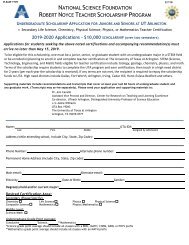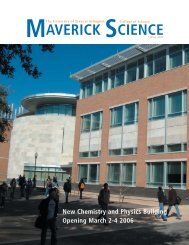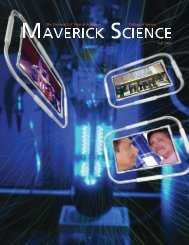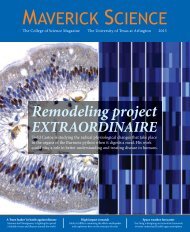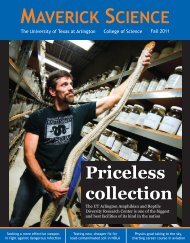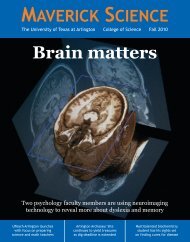Maverick Science mag 2013-14
You also want an ePaper? Increase the reach of your titles
YUMPU automatically turns print PDFs into web optimized ePapers that Google loves.
S c i e n c e S c e n e<br />
gineers and chemistry majors<br />
headed toward careers in drug development,<br />
epidemiology or food<br />
science. In addition, a $50,000<br />
portion of the Shimadzu gift was<br />
designated to establish the Shimadzu<br />
Undergraduate Research<br />
Excellence (SURE) Fund. That<br />
fund will be used to support innovative<br />
models in undergraduate research.<br />
“Our teaching labs are being<br />
employed to involve students as<br />
early as their freshman year,” said<br />
Joe Barrera, director of the institute.<br />
“This assures that all students,<br />
regardless of their chosen<br />
major, will train and learn on the<br />
same cutting-edge instruments<br />
that are found in the facilities. I feel<br />
this quote by an outside observer<br />
puts it into perspective: ‘UTA undergraduate<br />
students are training<br />
on instrumentation (teaching labs)<br />
usually reserved for advanced<br />
graduate students, while graduate<br />
students use instrumentation (facilities)<br />
usually reserved for experienced<br />
industry researchers.’ ”<br />
For students like Doug Carlton<br />
Jr. – a doctoral student and graduate<br />
research assistant whose research<br />
utilizes the Shimadzu<br />
Center for Advanced Analytical<br />
Chemistry (SCAAC) – the institute<br />
presents a unique opportunity to<br />
work with instrumentation that places no limits<br />
on what can be achieved.<br />
A student conducts an experiment by infusing solutions<br />
containing analytes into a mass spectrometer<br />
inlet to observe the degree of ion formation.<br />
“Our teaching labs are being employed to<br />
involve students as early as their freshman year.<br />
is assures that all students, regardless of their<br />
chosen major, will train and learn on the same<br />
cutting-edge instruments that are found in the<br />
facilities.”<br />
– Joe Barrera,<br />
Shimadzu Institute for Research Technologies director<br />
“The variety of instruments housed in the<br />
SCAAC is unmatched by any other academic laboratory<br />
and nearly unmatched by any industrial<br />
research laboratory,” Carlton said. “The same instruments<br />
that students are able to operate in the<br />
SCAAC and teaching labs are being used in all<br />
fields – environmental, energy, food and drug,<br />
forensic, and others – around the globe.”<br />
The SCAAC was the first component of the institute<br />
to open, in Spring 2012. Last summer, research<br />
conducted at the center by Shimadzu<br />
Distinguished Professor of Analytical Chemistry<br />
Kevin Schug and his lab group on potential contamination<br />
at private water wells near natural gas<br />
drilling sites made national and international<br />
headlines.<br />
“The partnership with Shimadzu brings the<br />
most cutting-edge technologies to UT Arlington<br />
in chemistry, biology, material science and many<br />
more,” Barrera said. “In addition, beyond having<br />
the instrumentation, we are maximizing its impact<br />
by (1) having an open-access policy and being<br />
available to all researchers not only here at UTA,<br />
but all North Texas researchers as well, and (2)<br />
hiring our own research staff in order to provide<br />
sample analysis to researchers across the world.”<br />
The University’s Animal Care Facility was renovated<br />
and upgraded in November <strong>2013</strong> and became<br />
part of the institute. The Nanotechnology<br />
Research Center, Center for Human Genomics<br />
and the Center for Materials Genome – which<br />
previously were operated by different<br />
departments – have been<br />
or are being transitioned to the<br />
Institute’s domain this spring.<br />
They will be joined this year by<br />
the Shimadzu Center for Bio-<br />
Molecular I<strong>mag</strong>ing, the Shimadzu<br />
Center for Environmental,<br />
Forensics and Material <strong>Science</strong>,<br />
and the Shimadzu Center for<br />
Brain I<strong>mag</strong>ing.<br />
The innovative research being<br />
done by UT Arlington faculty<br />
members and their students,<br />
combined with the technology<br />
that the University’s partnership<br />
with Shimadzu makes possible,<br />
will give UT Arlington students a<br />
distinct advantage in the job market<br />
once they earn their degrees.<br />
“For students, being able to<br />
discuss this unique, hands-on experience<br />
is quite reassuring for<br />
future employers,” Carlton said.<br />
“In many university research<br />
labs, a student is hampered by<br />
the question, ‘How can I make<br />
my research work with the instrument<br />
that I have?’ At UT Arlington,<br />
we are now challenged with<br />
the question, ‘How can I make<br />
the research phenomenal with all<br />
the instruments that I have?’ ”<br />
That’s just the kind of challenge<br />
that scientists love, and because<br />
of the Shimadzu Institute<br />
for Research Technologies, it’s going to be a common<br />
one at UT Arlington.<br />
A student uses a pipette, or chemical dropper, to<br />
transport liquid from a vial into a microwell plate<br />
for use in analytical research.<br />
<strong>Maverick</strong> <strong>Science</strong> <strong>2013</strong>-<strong>14</strong><br />
5



